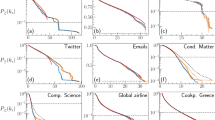Abstract.
We propose a method to determine the community structure of a complex network. In this method the ground state problem of a ferromagnetic random field Ising model is considered on the network with the magnetic field Bs = +∞, Bt = -∞, and Bi≠s,t=0 for a node pair s and t. The ground state problem is equivalent to the so-called maximum flow problem, which can be solved exactly numerically with the help of a combinatorial optimization algorithm. The community structure is then identified from the ground state Ising spin domains for all pairs of s and t. Our method provides a criterion for the existence of the community structure, and is applicable equally well to unweighted and weighted networks. We demonstrate the performance of the method by applying it to the Barabási-Albert network, Zachary karate club network, the scientific collaboration network, and the stock price correlation network. (Ising, Potts, etc.)
Similar content being viewed by others
References
R. Albert, A.-L. Barabási, Rev. Mod. Phys. 74, 47 (2002)
S.N. Dorogovtsev, J.F.F. Mendes, Adv. Phys. 51, 1079 (2002)
M.E.J. Newman, SIAM Rev. 45, 167 (2003)
H. Jeong, B. Tombor, R. Albert, Z.N. Oltvai, A.-L. Barabási, Nature (London) 407, 651 (2000)
P. Holme, M. Huss, H. Jeong, Bioinformatics 19, 532 (2003)
D. Wilkinson, B.A. Huberman, Proc. Natl. Acad. Sci. 101, 5241 (2004)
E. Ravasz, A.L. Somera, D.A. Mongru, Z.N. Oltvai, A.-L. Barabási, Science 297, 1551 (2002); E. Ravasz, A.-L. Barabási, Phys. Rev. E 67, 026112 (2003)
R.N. Mantegna, Eur. Phys. J. B 11, 193 (1999); G. Bonanno, G. Caldarelli, F. Lillo, R.N. Mantegna, Phys. Rev. E 68, 046130 (2003)
J.-P. Onnela, A. Chakraborti, K. Kaski, J. Kertesz, A. Kanto, Phys. Rev. E 68, 056110 (2003)
M. Girvan, M.E.J. Newman, Proc. Natl. Acad. Sci. 99, 7821 (2002)
M.E.J. Newman, Eur. Phys. J. B 38, 321 (2004)
M.E.J. Newman, M. Girvan, Phys. Rev. E 69, 026113 (2004)
M.E.J. Newman, Phys. Rev. E 64, 016131 (2001); M.E.J. Newman, Phys. Rev. E 64, 016132 (2001)
J.R. Tyler, D.M. Wilkinson, B.A. Huberman, e-print arXiv:comd-mat/0303264 (2003)
F. Radicchi, C. Castellano, F. Cecconi, V. Loreto, D. Parisi, Proc. Natl. Acad. Sci. 101, 2658 (2004)
S. Fortunato, V. Latora, M. Marchiori, Phys. Rev. E 70 056104 (2004)
M.E.J. Newman, Phys. Rev. E 69, 066133 (2004)
A. Clauset, M.E.J. Newman, C. Moore, Phys. Rev. E 70, 066111 (2004)
Y. Fu, P.W. Anderson, J. Phys. A 19, 1605 (1986)
M. Blatt, S. Wiseman, E. Domany Phys. Rev. Lett. 76, 3251 (1996)
J. Reichardt, S. Bornholdt, Phys. Rev. Lett. 93, 218701 (2004)
A. Vazquez, A. Flammini, A. Maritan, A. Vespignani, Nat. Biotechnol. 21, 697 (2003)
R. Guimerá, M. Sales-Pardo, L.A.N. Amaral, Phys. Rev. E 7-, 025101(R) (2004)
H. Zhou, Phys. Rev. E 67, 061901 (2003)
F. Wu, B.A. Huberman, Eur. Phys. J. B 38, 331 (2004)
A.A. Middleton, D.S. Fisher, Phys. Rev. B 65, 134411 (2002)
J.D. Noh, H. Rieger, Phys. Rev. Lett. 87, 176102 (2001); J.D. Noh, H. Rieger, Phys. Rev. E 66, 036117 (2002)
S.-W. Son, H. Jeong, J.D. Noh, unpublished
M. Alava, P.M. Duxbury, C. Moukarzel, H. Rieger, in Phase Transitions and Critical Phenomena, edited by C. Domb, J.L. Lebowitz (Academic, Cambridge, 2000) Vol. 18, pp. 141–317; A. Hartmann, H. Rieger, Optimization Algorithms in Physics (Wiley VCH, Berlin, 2002)
A.-L. Barabási, R. Albert, Science 286, 509 (1999); A.-L. Barabási, R. Albert, H. Jeong, Physica A 272, 173 (1999)
D.-H. Kim, H. Jeong, Phys. Rev. E 72, 046133 (2005)
J.D. Noh, Phys. Rev. E 61, 5981 (2000)
For Figure 3c, yellow and skyblue correspond to a group of scientists working primarily on the structure of RNA, orange, red, violet, pink, and green correspond to a group working primarily in statistical physics, lightgreen represents a group working on mathematical models in ecology, blue represents a group of scientists using agent-based models to study problems in economics and traffic flow
The tickers correspond to the following companies in the NYSE: Halliburton Co. (HAL), Kerr-Mc-Gee Corp. (KMG), Noble Energy Inc. (NBL), ConocoPhillips (COP), Schlumberger Ltd. (SLB), Chevron Texaco Corp. (CVX), Valero Energy Corp. (VLO), Exxon Mobil Corp. (XOM), BP PLC(BP), Royal Dutch Petroleum Co. (RD), Occidental Petroleum Corp. (OXY), Marathon Oil Corp. (MRO), and Apache Corp. (APA)
Each industrial cluster contains the following companies. Utilities (11 companies, skyblue): Southern Company Inc. (SO), Public Service Enterprise Group Inc. (PEG), PG&E Corp. (PCG), Exelon Corp. (EXC), Entergy Corp. (ETR), Edison International (EIX), American Electric Power Co. Inc. (AEP), Consolidated Edison Inc. (ED), DTE Energy Co. (DTE), CenterPoint Energy Inc. (CNP), and People Energy Corp. (PGL). Health care (6, green): Merck&Co. Inc. (MRK), Wyeth (WYE), Bristol-Myers Squibb Co. (BMY), Johnson&Johnson Inc. (JNJ), Eli Lilly and Co. (LLY), and Pfizer Inc. (PFE). Basic material (5, violet): Boise Cascade Corp. (BCC), Georgia-Pacific Corp. (GP), Louisiana-Pacific Corp. (LPX), Weyerhaeuser Co. (WY), and International Paper Co. (IP). Rail road (4, orange): Union Pacific Corp. (UNP), CSX Corp. (CSX), Burlington Northern Santa Fe Corp. (BNI), and Norfolk Southern Corp. (NSC). Airline (3, blue): AMR Corp. (AMR), Delta Air Lines Inc. (DAL), and Southwest Airlines Inc. (LUV).
L.R. Ford, D.R. Fulkerson Flows in Networks (Princeton University Press, 1962)
Author information
Authors and Affiliations
Corresponding author
Rights and permissions
About this article
Cite this article
Son, SW., Jeong, H. & Noh, J. Random field Ising model and community structure in complex networks. Eur. Phys. J. B 50, 431–437 (2006). https://doi.org/10.1140/epjb/e2006-00155-4
Received:
Published:
Issue Date:
DOI: https://doi.org/10.1140/epjb/e2006-00155-4




